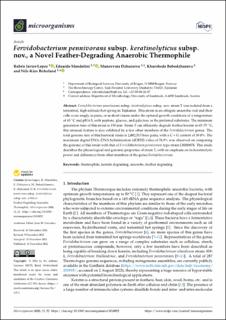| dc.contributor.author | Javier Lopez, Ruben | |
| dc.contributor.author | Mandolini, Edoardo | |
| dc.contributor.author | Dzhuraeva, Munavvara | |
| dc.contributor.author | Bobodzhanova, Khursheda | |
| dc.contributor.author | Birkeland, Nils Kåre | |
| dc.date.accessioned | 2023-02-09T13:46:02Z | |
| dc.date.available | 2023-02-09T13:46:02Z | |
| dc.date.created | 2023-01-24T15:15:17Z | |
| dc.date.issued | 2022 | |
| dc.identifier.issn | 2076-2607 | |
| dc.identifier.uri | https://hdl.handle.net/11250/3049784 | |
| dc.description.abstract | Fervidobacterium pennivorans subsp. keratinolyticus subsp. nov. strain T was isolated from a terrestrial, high-altitude hot spring in Tajikistan. This strain is an obligate anaerobic rod and their cells occur singly, in pairs, or as short chains under the optimal growth conditions of a temperature of 65 °C and pH 6.5, with peptone, glucose, and galactose as the preferred substrates. The minimum generation time of this strain is 150 min. Strain T can efficiently degrade feather keratin at 65–75 °C; this unusual feature is also exhibited by a few other members of the Fervidobacterium genus. The total genome size of this bacterial strain is 2,002,515 base pairs, with a C + G content of 39.0%. The maximum digital DNA–DNA hybridization (dDDH) value of 76.9% was observed on comparing the genome of this strain with that of Fervidobacterium pennivorans type strain DSM9078. This study describes the physiological and genomic properties of strain T, with an emphasis on its keratinolytic power and differences from other members of the genus Fervidobacterium. | en_US |
| dc.language.iso | eng | en_US |
| dc.publisher | MDPI | en_US |
| dc.rights | Navngivelse 4.0 Internasjonal | * |
| dc.rights.uri | http://creativecommons.org/licenses/by/4.0/deed.no | * |
| dc.subject | Anaerober | en_US |
| dc.subject | Anaerobes | en_US |
| dc.subject | Bioteknologi | en_US |
| dc.subject | Biotechnology | en_US |
| dc.subject | Ekstremofiler | en_US |
| dc.subject | Extremophiles | en_US |
| dc.title | Fervidobacterium pennivorans subsp. keratinolyticus subsp. nov., a Novel Feather-Degrading Anaerobic Thermophile | en_US |
| dc.type | Journal article | en_US |
| dc.type | Peer reviewed | en_US |
| dc.description.version | publishedVersion | en_US |
| dc.rights.holder | Copyright 2022 The Author(s) | en_US |
| dc.source.articlenumber | 22 | en_US |
| cristin.ispublished | true | |
| cristin.fulltext | original | |
| cristin.qualitycode | 1 | |
| dc.identifier.doi | https://doi.org/10.3390/microorganisms11010022 | |
| dc.identifier.cristin | 2114161 | |
| dc.source.journal | Microorganisms | en_US |
| dc.relation.project | Norges forskningsråd: 328955 | en_US |
| dc.subject.nsi | VDP::Generell mikrobiologi: 472 | en_US |
| dc.subject.nsi | VDP::General microbiology: 472 | en_US |
| dc.subject.nsi | VDP::Generell mikrobiologi: 472 | en_US |
| dc.subject.nsi | VDP::General microbiology: 472 | en_US |
| dc.identifier.citation | Microorganisms. 2023, 11 (1), 22. | en_US |
| dc.source.volume | 11 | en_US |
| dc.source.issue | 1 | en_US |

